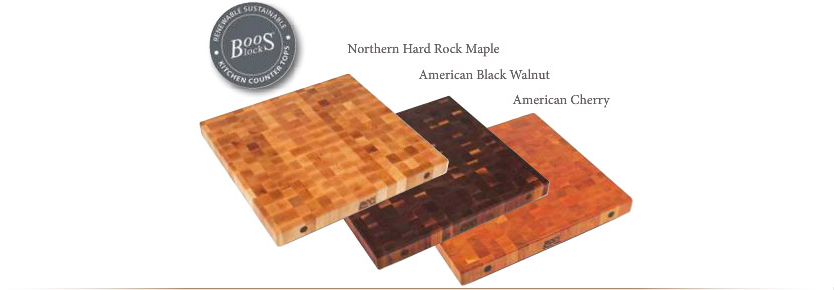1.800.667.8721 or Live Chat (9AM - 6PM EST)
Shop Butcher Block
Butcher Blocks
Types of Butcher Block
 End grain
End grainEnd grain butcher block is "true" butcher block made in the old-fashioned way to withstand chopping, dicing, and cutting. It is the most versatile of any type of cutting or chopping board. End grain blocks are made by usig glue and spaples to combine many pieces of wood with the grain of the wood facing up. They require more work to produce, are more durable and are often used in professional & commercial kitchens, cutting boards, chopping blocks and residential kitchen islands. This type of butcher block has a checker board appearance. If you have only one board in your kitchen, this is the best choice all around.

 Edge grain (long grain)
Edge grain (long grain)Edge grain, or long grain butcher block, lis used to make the majority of cutting boards sold throughout North America today. Edge grain butcher block is constructed by gluing many pieces of wood together. The grain of the wood in long-grain or egde grain blocks runs long ways, or horizontal with the work surface. The edge grain is turned up, and this is the hardest portion of a hard maple log or board, making it ideal for light dicing and cutting. This type of butcher block is easier to produce, is more affordable, and is used in countertops, table tops, work benches and 95% of the products referred to as butcher block.

 Blended- Grain
Blended- Grain
Blended grain butcher block is constructed by gluing many pieces of random lengths of finger-jointed interior rails together. The grain of the wood in long-grain or egde grain blocks runs long ways, or horizontal with the work surface. The edge grain is turned up. Blended grain offers a harmonious blend of heartwood, sap, natural mineral, and grain. This type of butcher block keeps costs down due to the short wood pieces that can be used.

Wood Species used in Butcher Blocks
Butcher block is available in a variety of wood species. The most
common species used are American Maple and Cherry. Occasionally,
teak, liptus, and walnut are also used in production. Liptus, in
recent years has become more and more popular as it is a more
renewable resource and therefore more suited to the environmentally
conscious. Liptus, however, is not as hard as maple and does have a
distinctively different color.
Butcher Block Finishes
VarnishedInitially, butcher blocks were not finished at all. Butchers would sand and oil their chopping blocks to keep them from drying out. Today, however, you can enjoy the beauty of a butcher block counter top or island for your kitchen without the need to regularly maintain it. Many butcher block products are available with a polyurethane coating or finish. This process of coating the wood is sometimes referred to as a "varnique"finish. Varnished butcher blocks provide a more finished or refined look. In addition to the countless benefits to a varnished butcher block, there are a few drawbacks.
- Some things to consider with varnique butcher blocks?
- Cannot be cut on
- Prone to scratching
- May require refinishing over time
- What are the benefits of a varnique finish?
- Longer surface life than many other counter top materials
- More finished/aesthetically pleasing look
- Resistant to stains
Butcher blocks in their natural state are considered the only option by many professional chefs. The look is more rustic and the uses for an oil finished butcher block are more versatile. If the intended use of the surface is to prepare and cut food, an oil finish is the only option, as varnished tops cannot be cut on. There are both pros and cons to an oil finished butcher block.
- Some things to consider with oil finished surfaces?
- Requires regular oiling
- Subject to staining
- What are the benefits of oil finished butcher blocks?
- The unfinished wood allows you to prepare & cut food directly on the surface
- Extremely durable work surface
- Oiled blocks are naturally resistant to bacteria
- Longer surface life than many other counter top materials
Products Containing Butcher Block
-
Butcher Block Counter tops
- Butcher block counter tops are becoming increasingly popular in the U.S. Available in end grain & long grain, and a variety of thicknesses, wood species, and finishes, butcher block countertops can be custom cut to your specifications. Additionally, accommodations can be made for sink cut-outs, backsplashes and more.
- Butcher Block Kitchen Islands
- A kitchen island featuring butcher block can complement just about any kitchen. From small portable kitchen carts, to large stationary kitchen islands, butcher block is being used in a variety of applications in today's kitchens. Butcher block islands and carts can be found for just about any budget.
- Butcher Block Cutting Boards & Chopping Blocks
- As previously mentioned, butcher block is naturally resistant to bacteria and considered by many professional chefs as the ideal surface for food preparation. Thus, cutting boards and heavy duty chopping blocks are often made from this material. With superior durability and aesthetics compared to other cutting surfaces, butcher block is available in a plethora of sizes & styles for chopping blocks and cutting boards. It's certain to make the home chef's experience more rewarding.
- As previously mentioned, butcher block is naturally resistant to bacteria and considered by many professional chefs as the ideal surface for food preparation. Thus, cutting boards and heavy duty chopping blocks are often made from this material. With superior durability and aesthetics compared to other cutting surfaces, butcher block is available in a plethora of sizes & styles for chopping blocks and cutting boards. It's certain to make the home chef's experience more rewarding.









